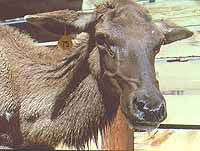| Elk with chronic wasting disease. |
The southeastern region regional advisory council for the Division of Wildlife Resources met at the John Wesley Powell River History Museum in Green River recently. This meeting is historically the one with the greatest attendance and 2004 was no exception.
Hunters gathered in the museum’s theater to discuss and listen to the proposed changes for the 2005 hunting seasons. The annual bucks and bulls meeting boasts a diverse gathering of concerned Utahns.
Following the routine business of the board, Chairman James Gilson introduced Derris Jones to give the regional update. Jones explained the numerous habitat projects that are ongoing. Many are rehabilitation or reseeding projects. Of the numerous projects in progress or scheduled to begin soon, nearly 3,000 acres are being reseeded or rehabilitated.
Jones stated that the DWR has fully monitored the deer harvested in every unit, with the exception of the Henry Mountains and the San Rafael units, for chronic wasting disease. There is also monitoring occurring in the harvested elk. One more confirmed case in deer has been documented in the LaSal Mountain unit for a total of eight cases in that area this year.
Jim Karpowitz, the big game program coordinator then explained the changes to the bucks, bulls and once in a lifetime proclamation for the 2005 season. It will be greatly condensed and contain fewer pages and be easier to read and understand. There will be short summaries of rules and reference locations for the full rule.
The statewide deer management plan states that the buck/doe ratio should be 15-20 bucks for every 100 does for a three year period. All regions in the state are at the lower end of the ratio and stand at 15, with the exception of the southern region which is at 16. Improvements are due to the buck/doe ratio on public lands and improvements of fawn production.
With the improvements in the deer herd the recommendations are to stay with same hunts and dates. One change was recommended to the Book Cliff Units. It was recommended to combine the three units into one hunting unit. No other major changes are recommended and the number of permits to be allowed will be set in the spring of 2005 after the spring counts have been tallied.
Karpowitz proceeded to the proposed changes in the elk management. He stated that in 2003, the Utah Wildlife Board instructed the DWR to form a citizen committee whose purpose would be to revise the statewide elk management plan for the future. The committee came to the conclusion that the elk management plan already in place is extremely effective and only needs some fine tuning.
The committee’s overriding objective was to find a way to hunt mature bulls without greatly sacrificing quality. The first thing they looked at was spike only units. Their proposal was to reduce the number of permits from 19,000 to 11,000 to increase the number of bulls that are carried over into older age classes. Another proposal was to shorten the length of the hunt from 13 to nine days. Over time, these changes will provide more opportunity for hunters to take larger bulls. The DWR accepted all the committees recommendations.
In regard to the rifle elk hunt, the proposal was made to add another late hunt. This season would be Nov. 12-18 and would move 30 percent of the tags to this season. If this hunt is approved, it would solve some late season depredation situations that have cropped up on both sides of the Manti. Hunters who put in for this hunt will have better chances to draw a permit and will allow those with fewer points to be successful in the draw.
For example, if an area had 100 tags, archers would get 25, muzzleloaders would get 15, early rifle hunters would get 39, late rifle hunters would get 19 and three would go into premium hunts. The premium limited entry hunting opportunity would provide a premium limited entry tag to a hunter who would be able to hunt all seasons for a premium fee. The number of tags would be less than five permits.
These changes are long term fixes and will take several years to realize the improvements. Another change that would take effect sooner would be to check the ages of harvested animals to all hunts. In the past it has been the practice to check only the rifle hunt animals. By gathering the data from all hunts, the average age of the harvested bulls will most likely go down.
If the age class objective is reduced, it will open up the opportunity for more hunting permits to be released. These permits will be for limited entry units and will not greatly affect the quality of the bulls. If the age class objective is not reduced, less hunting opportunity will result.
Bill Bates announced several changes that were recommended for the local area only. One recommendation was to create a late bull hunt on the public lands portions of Range Creek. Another recommendation was to extend the statewide general deer hunt to nine days. The RAC did not endorse the idea of lengthening the deer hunt. They voted to keep the deer hunt in the southeastern at five days for at least two more years.
The southeastern region RAC approved to support all other DWR recommendations with the exception of the age objective of the bulls in the southeastern region. RAC members were agreed in the recommendation not to change the age categories of the bulls in this area to maintain the quality of the hunts.

